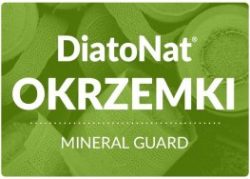
Our diatoms (diatomaceous earth) can be successfully used in poultry and other birds as a natural and environmentally safe agent against parasites, a source of available silicon for improving the condition of the skeleton and feathers and providing many other health benefits ...
Diatomaceous earth in prophylaxis of racial pigeons Małgorzata Wiewióra, Monika Łukasiewicz, Justyna Bartosik, Mateusz Makarski, Tomasz Niemiec, Department of Detailed Animal Breeding, Department of Poultry Breeding– Warsaw University of Life Sciences
Demand for silicon in shaping the skeletal system in chickens. Edith M. Carlisle, Department of Environmental and Nutrition Sciences, School of Public Health, University of California, Los Angeles, CA 90024
Demand for silicon in the formation of connective tissue and joint cartilage in chickens. Edith M. Carlisle, Department of Environmental and Nutrition Sciences, School of Public Health, University of California, Los Angeles, CA 90024
Silicon – an essential nutrient for chickens. Edith M. Carlisle, Department of Environmental and Nutrition Sciences, School of Public Health, University of California, Los Angeles, CA 90024
Influence of diatomaceous earth on soybean fertilization, egg production and egg quality in laying hens in ecological free-range farming. Bennett, A. Yee, K.M. Cheng, Y. J. Rhee; article published in the American Poultry Science Association Journal, a journal of the Scientific Society of Poultry Breeders
Amorphous diatomaceous earth as a feed additive for poultry. Dorota Szablicka, Marcin Różewicz; University of Natural Sciences and Humanities in Siedlce, Institute of Bioengineering and Animal Breeding, article published in Wiadomości Zootechniczne, R. LV (2017), 4: 112–117
Indicators of rearing and selected quality traits of meat and femur of broiler chickens fed with feed supplemented with amorphous diatomaceous earth. Małgorzata Wiewióra, Monika Łukasiewicz, Department of Detailed Animal Breeding, Department of Poultry Breeding – Warsaw University of Life Sciences
Article published in USDA – US Department of Agriculture, disinfection of broiler feces through the use of diatoms (diatomaceous earth)
An article written by scientists from the University of Guelph in Canada, Faculty of Sciences on Animals and Poultry, the effect of nutritional supplements in the form of silica on production efficiency, health and quality of manure in turkeys
An article written in the industry magazine Poultry Word, the effect of adding silica on a turkey diet
Diatomaceous earth in prophylaxis of racial pigeons. Małgorzata Wiewióra, Monika Łukasiewicz, Justyna Bartosik, Mateusz Makarski, Tomasz Niemiec, Department of Detailed Animal Breeding, Department of Poultry Breeding– Warsaw University of Life Sciences
Click to go to the original article
The aim of the study was to determine the effectiveness of the action of diatomaceous earth in the prophylaxis of raccoon pigeons and the forms of its administration. Diatomaceous earth (diatomite) was fed in dovecotes located in the Masovia Province. The addition of natural mineral was administered in an amount of 2% of the daily feed dose for three weeks in ten pigeons. The pigeons were divided into two groups. In group I 150 birds from five pigeons received grain (a mixture for pigeons from Kampol) and separately diatomaceous earth mixed with a complementary mineral feed mix (Biowet company). In group II 150 pigeons from the remaining 5 pigeons received diatomaceous earth mixed with grain (mixture for pigeons from Kampol). Three groups of parasites were identified in the feces of pigeons: eggs of nematodes of the genus Capillaria, eggs of nematodes of the genus Ascaridia and oocysts of coccinuts from the genus Eimeria. In the conducted experiment, in 5 pigeons (ZO + grain + Biowet mineral mix) complete elimination of parasitic eggs after one week of diatomaceous earth application, and in 5 others (ZO + grain) a clear reduction in the number of Capillaria nematode eggs and a decrease in the share of Eimeria coccidia oocysts.
Demand for silicon in shaping the skeletal system in chickens. Edith M. Carlisle, Department of Environmental and Nutrition Sciences, School of Public Health, University of California, Los Angeles, CA 90024/span>
Click to go to the original article
Click to go to the original article
Based on the research carried out, the author of the articles describes the effect of silicon-poor diet on the condition of the skeletal system in chickens. It turns out that a diet low in silicon leads to distortions of the skeletal system and poor condition of connective tissue. Research suggests that silicon is an important factor in the formation of the skeletal system in chickens at an early stage of growth.
Demand for silicon in the formation of connective tissue and joint cartilage in chickens. Edith M. Carlisle, Department of Environmental and Nutrition Sciences, School of Public Health, University of California, Los Angeles, CA 90024
Click to go to the original article
Click to go to the original article
The aim of the study was to investigate the influence of silicon on the growth and development of chickens. It was noted that silicon deficiency leads to abnormalities in the structure of the skeleton, joint cartilage and connective tissue comb.
Bones of cocks fed silicon-rich feed from day 1 and killed in week 4 had more joint cartilage and water than cocks fed with silicon-poor feed.
Research proves the important role of silicon in the formation of articular cartilage and in general connective tissue and skeletal structure.
Tests performed on an electron microscope showed the presence of silicon in the active calcium formation in young bones, which demonstrates the relationship between silicon and calcium in bone formation. Research on rats also showed the interdependence of silicon and calcium in bone formation. The increase in the silicon content caused an increase in the rate of their mineralization, especially visible in the diet low in silicon. In addition, silicon is present along with magnesium and fluoride in growing bone in chickens. Similar results were observed in rat studies.
Silicon – an essential nutrient for chickens. Edith M. Carlisle, Department of Environmental and Nutrition Sciences, School of Public Health, University of California, Los Angeles, CA 90024
Click to go to the original article
Silicon is essential for the normal growth and development of chickens. On one-day cockerels fed with an amino acid-based diet, there was markedly stunted growth and development during the first 2 to 3 weeks of life. Chickens subjected to the same diet with the addition of silicon showed a 50 percent increase and normal development in relation to chickens fed without the participation of silicon. Silicon meets the criteria as a micronutrient essential in the diet.
Influence of diatomaceous earth on soybean fertilization, egg production and egg quality in laying hens in ecological free-range farming. Bennett, A. Yee, K.M. Cheng, Y. J. Rhee; article published in the American Poultry Science Association Journal, a journal of the Scientific Society of Poultry Breeders
Click to go to the original article
Research on the effectiveness of the action of diatomaceous earth as an anti-parasite agent and increasing nutritional efficiency of feed and increasing production volume of eggs was carried out in laying hens in an ecological free-range for two groups differing in resistance to parasites [Bovan Brown (BB) and Lowmann Brown (LB)] . In half of the hens from each farm, 2% addition of diatomaceous earth was used in feed, the remaining half received feed without diatomaceous earth. The degree of sivatization was determined by counting the eggs of parasites in chicken faeces (FEC – fecal egg count) twice a week and by posthumous examination of the digestive tract of chickens. The addition of diatomaceous earth to chickens more resistant to parasites (LB) did not significantly reduce the FEC and the number of adult parasites. However, chickens from the BB group, which were given diatomaceous earth, had clearly smaller numbers of eggs from the Capillaria and Heterakis parasites and a slightly smaller number of Eimeria parasitic eggs in the feces. Both BB and LB chickens fed with food with the addition of diatomaceous earth were clearly heavier and carried more eggs. In addition, BB chickens carried larger eggs that contained more protein and yolks than eggs of BB hens fed without the addition of diatomaceous earth. In another experiment, infection with the mite Ornithonyssus sylviarum was tested. In this case, both groups of hens fed feed with the addition of diatomaceous earth had less mites than chickens fed with diatomaceous fodder. The results of the study indicate that diatomaceous earth can be an effective means of controlling parasites in laying hens in ecological free-range farming.
Amorphous diatomaceous earth as a feed additive for poultry. Dorota Szablicka, Marcin Różewicz; University of Natural Sciences and Humanities in Siedlce, Institute of Bioengineering and Animal Breeding, article published in Wiadomości Zootechniczne R. LV (2017), 4: 112–117
Click to go to the original article
Summary.
Diatomaceous earth as a product of completely natural origin, at the same time safe, showing no toxic effects on animals and the environment, is a valuable feed additive for farm animals, including poultry. It is the source of an important element, which is silicon in the form of silica, necessary for the proper functioning of the bird organism and formation of bones in young animals. In the conducted research, it was also found that this additive also possesses antiparasitic properties, which is why it can be an alternative to synthetic drugs and preparations, especially on organic farms. In addition, as shown by the studies, diatomaceous earth is also a very good absorbent that reduces the effect of aflatoxin. Such a multidimensional beneficial effect of this supplement on poultry means that in the future it may be used more widely, also in intensive farming.
Indicators of rearing and selected quality traits of meat and femur of broiler chickens fed with feed supplemented with amorphous diatomaceous earth. Małgorzata Wiewióra, Monika Łukasiewicz, Justyna Bartosik, Mateusz Makarski, Tomasz Niemiec, Department of Detailed Animal Breeding, Department of Poultry Breeding – Warsaw University of Life Sciences
Click to go to the original article
Summary.
The aim of the study was to analyze the effect of amorphous kieselguhr additive on feed on the rearing results and selected quality traits of meat and femur of broiler chickens. The study was carried out on 60 quick-growing Ross 308 chickens kept until the 42nd day of life and divided into a control group (C) and two experimental groups (D2 and D4), 20 items each. Diatomaceous earth (diatomite) was given with feed to birds from the D2 group – 2%, D4 – 4%. Weight, feed intake and chicken mortality were controlled in the experiment. On the 42nd day of rearing, 6 cocks were slaughtered from each group and dissection was performed. The slaughtering capacity, the share of muscles and edible offal (muscle, liver and heart) were calculated, and in the breast and leg tests chemical and physicochemical analyzes were performed. The femoral strength for fracture was also determined. The addition of diatomite did not affect the health status of chickens. Higher body mass on the 42nd day of rearing was recorded in group C vs D4 (P ≤0.05). There was a higher (P ≤0.01) proportion of breast muscles and a smaller (P ≤0.05) fat content in the carcass in the D2 vs C group. The addition of diatomaceous earth to feed did not differentiate the chemical composition of breast muscles. In the leg muscles of D2 cocks, a decrease (P ≤0.05) in fat content and an increase (P ≤0.05) in water content compared to group C. Femoral females from group D4 were characterized by a higher (P ≤0.05) fracture strength than chicken bones with C. The proportionality between the amount of applied diatom in the feed and the strength of the femur was found. The supplementation to feed at the level of 2% was considered the most optimal.
